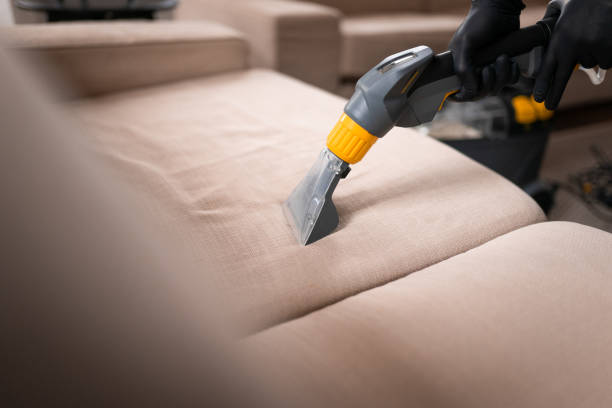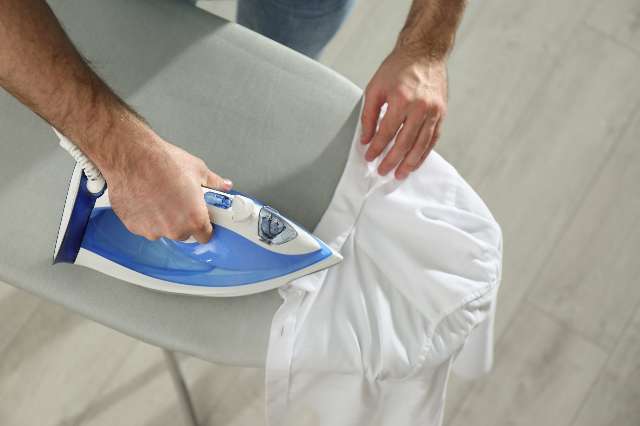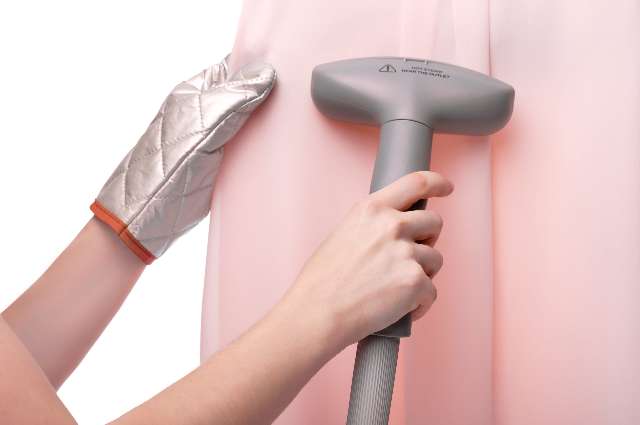
Your coach is your safe haven, a place of refuge after a long day’s work. And because it’s the place where you sit through marathon TV sessions and host impromptu naps, it tends to get pretty dirty.
From crumbs to spills, your fabric couch sees it all — but thankfully, it doesn’t have to stay that way. With a little TLC (and the right cleaning tools), you can have your couch looking as good as new in no time.
Here’s everything you need to know about how to clean a fabric couch:
Read the Manufacturer’s Instructions
This is always your first step when cleaning any piece of upholstered furniture. Every fabric couch is different, as some are made with delicate materials that can’t withstand certain cleaning products or methods.
Check Your Sofa’s Tag
If manufacturer cleaning instructions aren’t available, check its fabric upholstery cleaning codes. These will inform you on whether your couch’s fabric can be cleaned with water or with dry-cleaning solvents, or if it’s best to just vacuum and spot clean.
Here are the most common codes:
W – Users can use a water-based solution or foam.
S – Users can use solvent based cleaners
W/S – Both water and dry-cleaning solutions can be used
X – Users should only vacuum or brush the fabric
Prepare Your Couch for Cleaning
Before you start cleaning your fabric couch, do a surface clean. While you’re not penetrating the fabric, you will remove any dirt, dust, or debris that’s sitting on top. This will make the deeper cleaning process much easier (not to mention more effective).
To do a surface clean, start by giving your couch a good vacuum cleaning. Use the upholstery brush attachment to get into all the crevices and corners, and ensure to vacuum both the front and back of the couch.
Afterwards, use a stiff brush to gently loosen any dirt or debris that’s stuck to the fabric. Be careful not to brush too hard as this could damage the couch. Proceed to vacuum a second time to ensure that you’ve picked up all the dirt.
Deodorise and Clean Your Couch
If your couch is starting to smell a bit musty, it’s probably due to trapped odours. The best way to do a quick clean whilst also deodorising your couch is to sprinkle baking soda over the entire surface.
Let the baking soda sit for at least 30 minutes, then vacuum it up using the upholstery attachment. You should notice a significant difference in both how your couch looks and smells.
However, if you have set-in stains in your sofa fabric, you may need to use a more powerful cleaning solution, which we’ll come onto below:
How to Clean Stains on Fabric Sofa
Once you’ve done a surface clean, you can start working on any stains. Depending on the couch fabric type, you’ll want to use different cleaning solutions and methods. As mentioned, always refer to your manufacturer’s instructions or upholstery codes to avoid damaging your couch.
Deep Cleaning your Couch with Baking Soda
Baking soda does wonders in deodorising and removing fabric sofa stains — making it the perfect choice for cleaning fabric couches. It’s a cost-effective solution that’s gentle enough to use on most types of fabric.
- To clean stains with baking soda, start by mixing equal parts baking soda with water to make a paste.
- Using a clean cloth or sponge, apply the paste to the stained area and rub it in gently.
- Let the baking soda paste rest for 15 to 20 minutes and let it work its magic.
- Once the stain has lifted, gently wipe away the paste.
How to Clean Fabric Sofa with Vinegar, Dish soap and Water
Spot-cleaning your couch with vinegar is a great way to remove small stains. The vinegar’s acidity efficiently breaks down and dislodges dirt and residue, making it easier to lift. It’s also safe for all fabrics due to its mild acidity.
- Mix three tablespoons of white vinegar with 1-2 tablespoons of dish soap and water.
- Dip a clean sponge or cloth into the mixture and gently scrub the stained area. Make sure not to soak the fabric.
- Continue scrubbing until the stain disappears, and use a clean, dry microfiber cloth to remove any residue.
- Let the area air dry or repeat the process if stains persist.
How to Deep Clean Couches
Sometimes, couch cleaning goes beyond simply spot cleaning or vacuuming. If your couch is looking a bit worse for wear, it might be time to give it a deep clean. This primarily combines the methods we’ve already gone over, but on a larger scale.
To deep clean your couch, do the following:
- Surface clean – Vacuum and brush the couch to remove any dirt, dust, or debris.
- Deodorise – Sprinkle baking soda over the entire couch and let it sit for 15-20 minutes.
- Spot clean – Focus on any areas with stains and use a vinegar/dish soap and water solution. Alternatively, you can make a baking soda paste (baking soda and water) and apply it to the stain.
- Let it dry – Let the couch air dry completely before using it again. Refrain from using hair dryers to speed up the process as it can do more harm than good.
How to Clean a Fabric Sofa with a Steam Cleaner
If your sofa permits water-based cleaning, then an upholstery steam cleaner is an excellent way to clean it. This will efficiently penetrate deep into the fabric to break apart any dirt, dust or stains.
Just check to make sure your sofa is marked with ‘W’ or ‘WS’, otherwise, you could damage the fabric.
To clean your sofa with a steam cleaner, do the following:
- Prepare your couch by vacuuming it with the upholstery attachment to remove any surface dirt or debris.
- Ensure the room is well ventilated to prevent moisture build-up.
- Remove cushions and steam clean them on both their sides
- Proceed to steam clean your couch using a handheld or upholstery steam cleaner. Start from the top of the couch and work your way down slowly.
- If your steam cleaner uses a microfiber cloth, make sure to change it frequently to avoid re-depositing dirt back onto the couch.
- Once you’re finished, let it air dry or point your fan towards the couch to speed up the process.
- Do not sit on or use the couch until it’s completely dry.
How to Disinfect Your Couch
Your couch can quickly harbour pathogenic bacteria, dust mites, and other nasties. Disinfecting your couch is a great way to keep it sanitary, ensuring it’s safe to relax. This is especially relevant among households with pets or small children.
To disinfect your couch, use a solution of:
- 1 cup of water
- 2 cups of alcohol
Pour and mix into a bottle and spray onto the couch. Focus on areas that are most likely to harbour bacteria, such as armrests, cushions and head rests. Just make sure not to soak the couch as a light mist will suffice. Let the couch air dry or use a clean, dry cloth to remove any moisture.
How Do I Dry Clean My Couch?
We’ve gone through a few liquid cleaning methods for couch cleaning, but what about dry cleaning methods? The simplest way to purchase a dry-cleaning agent from the store, which you can use at home.
- Double-check your sofa’s tag to see if it’s dry-clean only.
- Ventilate the room you’ll be cleaning in as dry-cleaning solvents can be harsh.
- Pre-treat any spots or stains with your dry-cleaning agent, gently rubbing it in.
- If you’re unsure, follow the instructions on your dry-cleaning agent to proceed with cleaning your couch.
- Remove your dry-cleaning agent once you’re finished and let your couch air out in a well-ventilated room.
How to Clean a Polyester Couch
Polyester and most synthetic fabrics are generally easy to care for and don’t require much special attention. However, going overboard by scrubbing or using harsh chemicals can actually damage the fabric so it’s important to use a gentle hand.
To clean a polyester couch:
- Damp a sponge or cloth and gently wipe any spills or stains.
- For tougher spots or grease stains, use a small amount of dish soap on the affected area.
- Proceed to lightly brush the stain until it’s completely removed.
- Just always remember not to soak the fabric, as water can penetrate the surface and cause damage.
How to Shampoo a Couch
Shampooing your couch fabric with specialist couch cleaner will work great on most fabrics but for deeper cleaning. However, this will only work with couches that can handle moisture-based cleaning. Always check the care tag to see if your couch can be shampooed before proceeding.
To shampoo your couch:
- Vacuum the couch to remove any surface debris.
- Mix your couch cleaner according to the instructions on the bottle.
- Shampoo your couch one section at a time and suck up the dirty water with your cleaner
- Blot wet areas with a clean, dry cloth to remove any excess moisture.
- Let the couch air dry in a well-ventilated room.
When shampooing your couch, ensure not to soak the fabric as this can potentially lead to mould growth if not dried properly.
How to Clean Fabric Cushion Covers
It’s not only your couch that can get dirty but your couch cushions as well. Your cushion covers can quickly become stained from spills, body oils, and general everyday dirt and debris. Since they’re primarily what you sit or lay on, it’s important to keep them clean and free of any nasties.
Cushion covers, depending on their material, can be put in a washing machine but it’s always best to check the care label first. Ensure your cycle is on a cold setting and use a dye-free detergent. You can also spot-clean your cushion covers using the same method as you would for your couch fabric.
The main thing you want to avoid is shrinkage, so if in doubt, hand wash your cushion covers instead.
Tips to Keep Your Couch Clean Long-term
Now that you know how to clean your couch, it’s time to focus on preventing stains and dirt in the first place. By taking a proactive approach, you can keep your couch looking newer for longer. This means not having to clean as often and your couch will thank you for it.
Here are some tips on how to keep your couch clean:
- Vacuum regularly at least once a week to remove any surface dirt and debris.
- Use covers and blankets – these are great for protecting your couch from spills and stains.
- Keep food and drinks away from the couch or use placemats when eating
- Keep shoes off whilst laying on the couch to prevent tracked-in dirt
- Treat your couch with a fabric protectant – this will help repel spills and stains.
- Attend spills, stains, and dirt immediately – the longer you leave it, the harder it will be to remove.
- Avoid cleaning with darker coloured cloths on lighter coloured furniture as this can cause textile dyes to bleed.
- Don’t forget to clean under and around your couch – this is often where a lot of dust and dirt can accumulate.
- Include couch cleaning into your house cleaning checklist and regular cleaning routine.
By following these simple tips, you can keep your couch clean and fresh for much longer. And if you do spill drinks or accidentally cause a stain, you’ll know exactly how to clean it up quickly and easily.
How to Clean Fabric Couch Takeaways
- Always vacuum clean before moving on to a deeper clean.
- Check the care label to see what cleaning method is best for your particular fabric.
- Use baking soda to deodorise and freshen up your couch.
- Remove sofa stains using either a baking soda paste, a white vinegar, dish soap and water solution or a store-bought upholstery cleaner.
- If your couch needs to be exclusively dry-cleaned, purchase a dry cleaning product from your local store.
- Always test your chosen solution in an inconspicuous area first.
- Never soak your fabric couch, as this can lead to mould growth.
- Clean your fabric cushion regularly to keep them looking fresh and new.
Couch Cleaning FAQ
How do you clean a couch without damaging it?
Before making any solutions or using specialised cleaners, always check the care label on your couch. This will give you an indication of the best way to clean your particular fabric without damaging it.
In general, natural cleaning solutions such as white vinegar mixed with water or baking soda are safe to use on most fabrics. However, it’s always best to test on an inconspicuous area first before applying it to the solution.
How long does it take for the sofa to dry after cleaning?
It can take between eight to twelve hours for your couch to fully dry after cleaning. However, this will depend on the fabric and how much water you used. If you want to speed up the drying time, you can use a fan, blot wet areas with a clean towel, or open up any nearby windows to help circulate air.
Can you use carpet cleaner on the couch?
Yes. Carpet cleaners can be used on upholstery. However, you will need to ensure your carpet cleaner has a hose attachment. This will suck excess water from the couch, allowing it to dry faster.
Can you save a wet couch?
Yes. However, the longer it takes you to act, the more damage that could be caused. Try to soak up as much water from the couch as possible using a clean high-volume fan, towels, or a dehumidifier. Whilst we refrain from recommending hairdryers, in this instance using the lowest heat setting could help dry the couch out.
If you enjoyed this article on how to clean a fabric couch, you might also like our other cleaning tips and tricks. For more helpful tips, be sure to check our wallpaper cleaning guide.
While the DIY methods mentioned above are effective for regular maintenance and minor stains, there are times when a couch might benefit from a deeper, professional clean. This is especially true for stubborn stains or if it’s been a while since the last thorough cleaning. Professional upholstery cleaning not only ensures a thorough cleanse but can also help in extending the lifespan of your furniture. For those interested in understanding the intricacies of professional upholstery cleaning and what it entails.
The Benefits of Professional House Cleaning Services for Couch Maintenance
While DIY methods are effective for regular upkeep, there’s unmatched value in hiring professional house cleaning services for your fabric couch. Professionals bring expertise, advanced cleaning tools, and eco-friendly solutions that ensure a deeper, safer clean. This not only preserves the beauty and longevity of your couch but also saves you time and effort, guaranteeing satisfaction with every service.
Hire Sidepost’s Professional House Cleaners
If you’re looking for a professional cleaning service, look no further than Sidepost. Our certified and experienced professionals have the tools and know-how to efficiently and effectively clean your fabric sofa and home. Contact us at 1300 138 499 or book online for a free quote.
We service all major Australian areas including Melbourne, Sydney, Brisbane, Perth, Adelaide, Canberra, Newcastle and Gold Coast.
Air Conditioning ( 3 )
Blinds installation ( 3 )
Building and Pest Inspections ( 4 )
Car Detailing & Car Wash ( 3 )
Carpet Cleaning ( 3 )
Carpet Installation ( 2 )
Custom Fish Tanks ( 2 )
Dry cleaning and ironing ( 3 )
Fencing Contractors ( 5 )
House Cleaning ( 7 )
House Painting ( 6 )
Ironing Service ( 1 )
Lawn Mowing ( 3 )
Pest control ( 2 )
Pool cleaning/servicing ( 3 )
Pressure Washing ( 2 )
Uncategorized ( 6 )
Professional Home Services at your Door
Get it all done with Sidepost - House cleaning, fencing, painting, and more.

